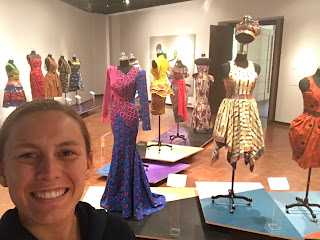For my final extra credit blog, I decided to attend the African-Print Fashion Now! exhibit at the Fowler Museum on campus – and I am so glad that I did. This art gallery was not what it seemed at first glance. When I entered the gallery, I was struck by all of the incredible colors and patterns that the textiles reflected throughout the room. There were cloth samples of a variety of patterns, as well as a plethora of mannequins adorned in beautifully constructed garments. At first, I was mesmerized by the clothes themselves, but I realized so much more after I started to read the blurbs that were placed next to each photograph, garment, and textile. This exhibit was about much more than just clothes, and as I began to understand the history behind the development, popularization, and production of these textiles and clothes, I understood why it had been included as an event option in this class.

 In the
beginning, these African-print styles were made locally in Africa, and were
designed, dyed, sewn and overall produced by hand by women in different
villages across the continent. However,
as it started to gain global popularity, the production of these uniquely
colorful patterned designs started to spread and be produced all over the world
– including Europe, but largely in Asian countries. Because of this widespread production,
especially in Asia, people began to buy these textiles from Asian factories
rather than the origins in Africa. Since
Africa, historically and today, is a place that faces economic hardship, it is
increasingly hard to turn down clothes made in Asia that are cheaper than the
local producers. I was intrigued by
this, because in my experience, this is happening with all sorts of commodities
throughout the world. We are always
looking for bigger, better, faster, and cheaper options – which often leaves
local and smaller businesses out to dry.
This phenomenon is directly related to technology – because technology
allows for mass production, which in turn replaces the need for human workers and
increases economic efficiency. No matter
how fast these local seamstresses and designers work, they will never be able
to keep up with mainstream factories who are able to sell their product for a
cheaper price.
In the
beginning, these African-print styles were made locally in Africa, and were
designed, dyed, sewn and overall produced by hand by women in different
villages across the continent. However,
as it started to gain global popularity, the production of these uniquely
colorful patterned designs started to spread and be produced all over the world
– including Europe, but largely in Asian countries. Because of this widespread production,
especially in Asia, people began to buy these textiles from Asian factories
rather than the origins in Africa. Since
Africa, historically and today, is a place that faces economic hardship, it is
increasingly hard to turn down clothes made in Asia that are cheaper than the
local producers. I was intrigued by
this, because in my experience, this is happening with all sorts of commodities
throughout the world. We are always
looking for bigger, better, faster, and cheaper options – which often leaves
local and smaller businesses out to dry.
This phenomenon is directly related to technology – because technology
allows for mass production, which in turn replaces the need for human workers and
increases economic efficiency. No matter
how fast these local seamstresses and designers work, they will never be able
to keep up with mainstream factories who are able to sell their product for a
cheaper price.  I feel that
this gallery relates to this class on more of an artistic level, but can also
be related to technology if you look at the broad scale involvement in overseas
production. I think that these patterns and
textiles are incredible works of art, and have clearly established their
dominance in the local and foreign fashion markets. However, I think that similar to other art
forms, our societal values centered around consumerism have lead us to forget
about the roots of this art of fashion, and instead has turned it into a money-making
business. I really enjoyed seeing the
work of many African based artists in this museum, and feel that I have a new
appreciation for the work they do. I also realized that we as a society have to
review what our priorities are, and I think that preserving the integrity of an
art form rather than turning it into a commodity for purchase needs to be
changed. I would highly recommend this
exhibit not only for the incredible visual appeal of the clothing, but also the
story behind it.
I feel that
this gallery relates to this class on more of an artistic level, but can also
be related to technology if you look at the broad scale involvement in overseas
production. I think that these patterns and
textiles are incredible works of art, and have clearly established their
dominance in the local and foreign fashion markets. However, I think that similar to other art
forms, our societal values centered around consumerism have lead us to forget
about the roots of this art of fashion, and instead has turned it into a money-making
business. I really enjoyed seeing the
work of many African based artists in this museum, and feel that I have a new
appreciation for the work they do. I also realized that we as a society have to
review what our priorities are, and I think that preserving the integrity of an
art form rather than turning it into a commodity for purchase needs to be
changed. I would highly recommend this
exhibit not only for the incredible visual appeal of the clothing, but also the
story behind it.


Comments
Post a Comment